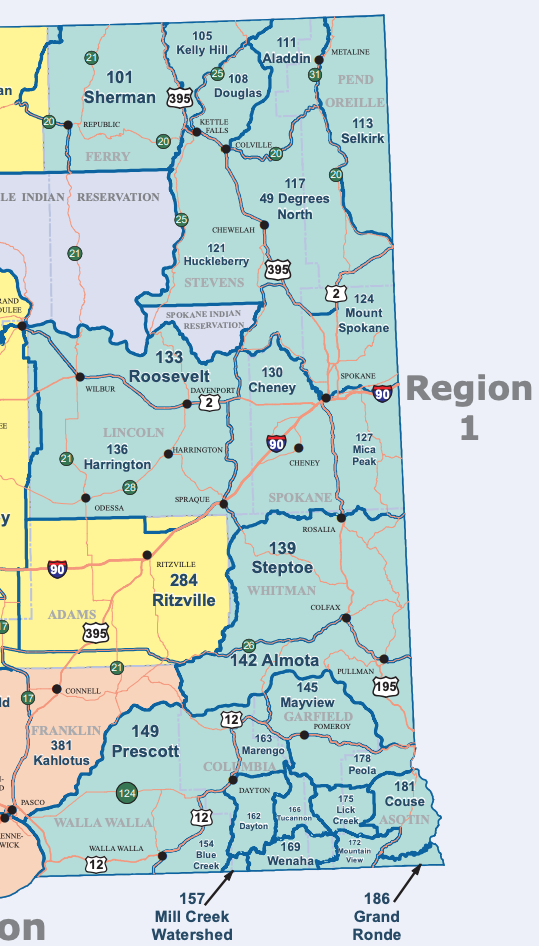
WA Hunter Reminder: New CWD Rules In Place For Spokane-area, 100-series GMUs
Camo? Check.
Binoculars? Check.
CWD rules? Uhhhhh, run those past me once again, please …
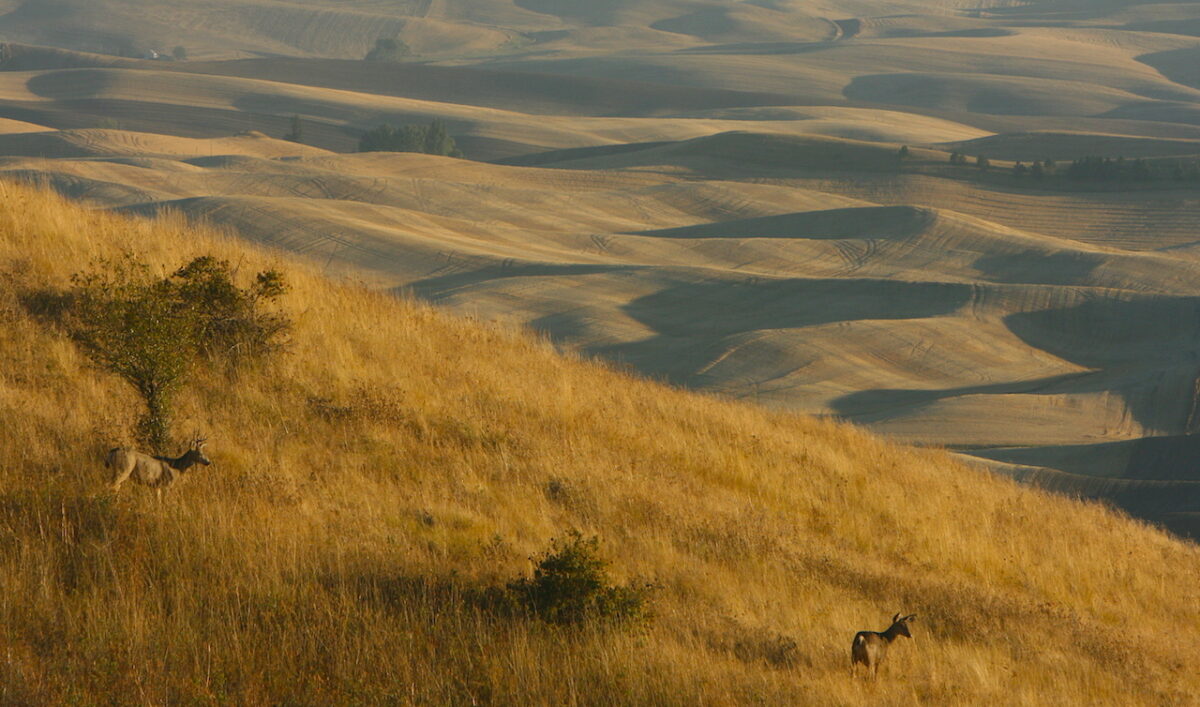
Indeed, with Washington’s 2024 season starting this Sunday, September 1, for archery bucks and does, Evergreen State deer, elk and moose hunters have a whole new wrinkle to consider as they plan their hunt following the confirmation this summer of chronic wasting disease in a dead whitetail doe and new emergency rules put in place just last week by WDFW as a response.
Three Spokane-area game management units have new testing requirements for all successful hunters as well as bans on the use of bait and ungulate-derived scent products to bring in critters, and there are also new carcass movement rules for animals taken in GMUs up and down the entire eastern tier of the state to be aware of.
It’s a lot, it’s complicated and it’s coming at sportsmen fast, but WDFW staffers are working to quickly get the word out – updating their CWD page with FAQs (also see below), producing a new map to help show the locations of carcass testing stations and landfills for disposal and more, posting new graphics about what animal parts are OK to move around where, sending out emails, and making appearances on social media.
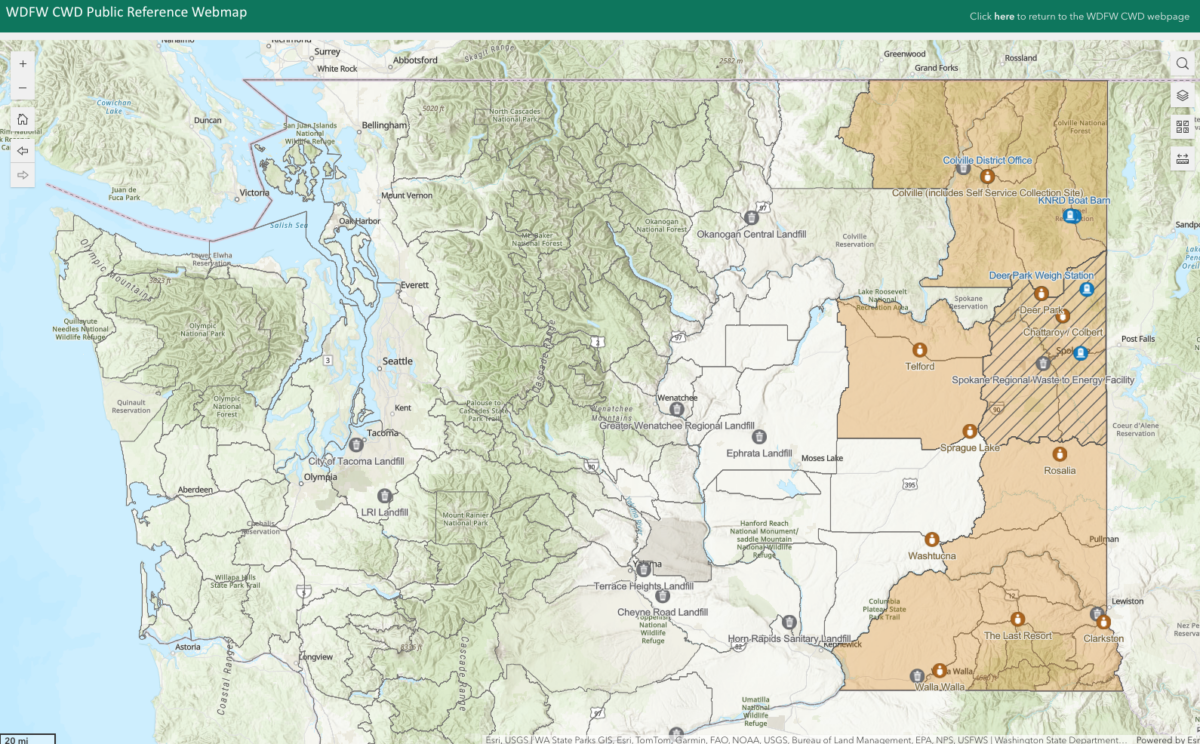
Last night saw Dr. Donny Martorello, WDFW Wildlife Program chief scientist, go on Fish Hunt Northwest and acknowledge that voluntary CWD sampling efforts in recent years hadn’t quite met the agency’s testing objective of being able to detect the disease at very low levels, but he still believes it has likely been caught early.
“But this just reinforces how important that point you just brought up is – sample acquisition is our tool to measure the distribution of this disease and the prevalence on the landscape,” Martorello told cohosts Tommy Donlin and Duane Inglin.
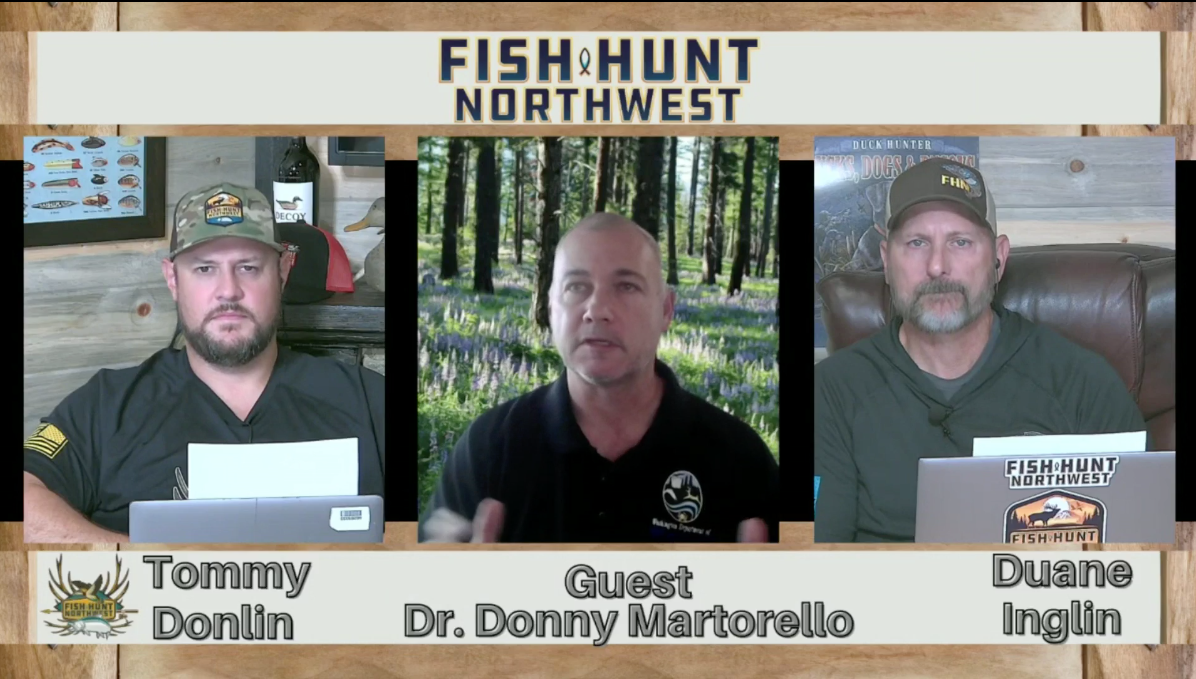
That’s the idea behind the mandatory deer, elk and moose sampling requirements in GMUs 124, 127 and 130, Mount Spokane – where CWD was first confirmed – Mica Peak and Cheney, respectively, which mandates either the animal’s whole head plus 3 inches of attached neck, or the extracted lymph nodes, be submitted to WDFW within three days of harvest for CWD testing.
Martorello told FHN that last year, in the neighborhood of 5,438 general season deer hunters and 1,975 elk hunters bagged approximately 1,400 whitetails and muleys and 240 wapiti in those three units, along with another 25 moose by special permit. If 2024 is similar, this season will generate a lot of samples that will help get a better handle on how widespread the disease outbreak may be. Similar testing rules apply to roadkill salvagers.
“Hunter and salvagers submitting a sample is critical because it enables the Department to track the distribution and prevalence of the disease so the Department can then inform the public on these important questions and put the right combination of strategies in place to try to contain the disease,” Martorello told this blog this afternoon.
No doubt there will be some hunters who refuse to get their animal tested for whatever reason, but failure to comply with sampling requirements – either in person at a game check, at a self-service dropoff location or by appointment – is a misdemeanor, Martorello noted.
He also told this blog that WDFW’s first preference is that successful 100-series GMU deer, elk and moose hunters leave their harvest’s spine, bones and brains on the hill where they killed it but bring out the retropharyngeal lymph nodes – located at the back end of the animal’s lower jaw – for testing, along with the meat, of course.
The agency’s second preference is for hunters to just bring out the whole head and 3 inches of neck (along with the meat) to a check station during modern firearm season, go to WDFW’s website and make an appointment to get it checked or drop it off at a testing kiosk.
If the bones have to come out of the field, a number of landfills that take them have been identified (see the aforementioned map), or they can be double bagged and put out in the trash to go to the landfill, he said.
Under WDFW’s new rules governing the transportation of animal parts, only these items can be moved from any 100-series GMU to units outside of there:
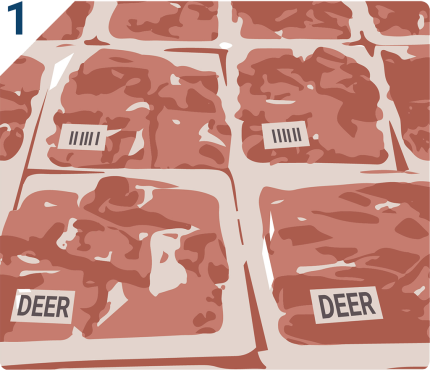
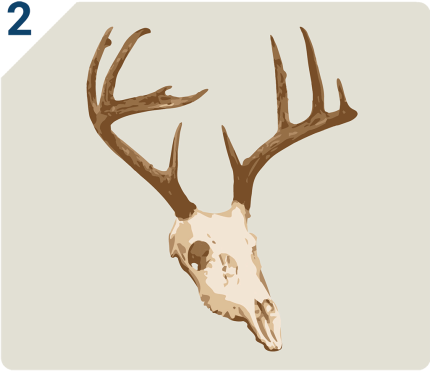
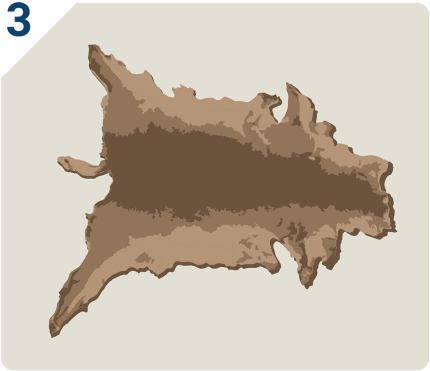
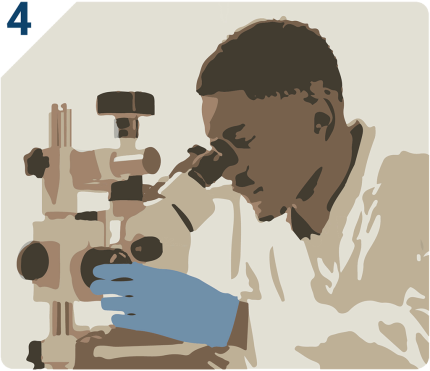

Those rules will actually be familiar to Evergreen State hunters who’ve pursued deer, elk and other game in CWD-positive states and provinces in recent years and decades, but will be new to those who do all their big game hunting in the confines of Washington.
Martorello said that agency offices are getting a lot of calls now about “emaciated deer,” but it’s difficult to tell if an animal has CWD – the disease doesn’t present till late on and is associated with a gaunt figure and droopy ears.
WDFW is recommending hunters not harvest any deer, elk or moose that looks sick or acting oddly; to use eye protection and disposable gloves for field dressing and butchering; avoid cutting through the spine or into the brain cavity, where the prions that cause CWD are concentrated; washing hands after processing a carcass and using a bleach solution to disinfect knives and other tools; and to safely dispose of inedible bits and NOT just dump them willy nilly in the woods, as CWD can remain in the ground and potentially infect other animals or lead to outbreaks in new areas.
Martorello said that sample batches will be submitted to a testing laboratory once a week, with results expected back within four to six weeks. Hunters can check their results online.
For the 2024 big game season, anybody who happens to kill an infected animal can get a replacement tag IF their hunt will still be open, he said. For instance, a bowhunter who kills a whitetail in September, submits a sample, receives a positive result by the end of the month or mid-October could theoretically be able to get a new tag in time for the late archery deer season.
“CWD has not been shown to infect people, but research is still ongoing, and it is not known for certain if people can get infected with this disease,” WDFW adds. “While CWD has not been associated with human disease, there is a theoretical risk to people who eat an infected animal. As a precaution, the Washington State Department of Health and the Centers for Disease Control and Prevention recommend that people do not eat any animal that tests positive for CWD or appears to have CWD.”
WDFW’s emergency CWD rules are good for 120 days, a period that runs to around the winter solstice, and according to Martorello, the agency is likely to extend them another four months, as well as ask the Fish and Wildlife Commission at some future point to make them permanent.
EDITOR’S NOTE: As a public service, here are WDFW’s frequently asked questions about CWD and hunters:
Q: If I harvest a deer, elk, or moose in a 100 series game management unit (GMU) can I take it to another 100 series GMU to process?
A: Yes. Deer, elk, and moose that originate in the 100 series GMUs may be transported between 100 series GMUs but can’t be transported as whole carcasses outside of the 100 series GMUs. You can take whole carcasses to a different GMU as long as it remains within the 100 series.
Q. I usually take the deer that I harvest in 100 series GMUs to my home in another area of the state for processing. I understand that I can’t do that anymore and will need to field process it. How should I get rid of the carcass?
A. If possible, leave as much of the carcass in the field as you can so as to avoid moving CWD prions to areas where they aren’t already. If that isn’t an option, WDFW is in the process of creating a map that shows disposal options for carcasses so check back to this page.
Q: Once I submit a deer, elk, or moose head for sampling, do I get the head and antlers back?
A: Yes. As long as the head isn’t frozen and the retropharyngeal lymph nodes can be extracted, the head and antlers are returned to the hunter. If you don’t want it, the agency can dispose of it. Heads dropped off at self-service kiosks are not able to be returned but tools are available at kiosks to remove antlers prior to depositing the head.
Q: The new rules say I can only take boned-out meat from the 100 series GMUs, so I can’t take my antlers and cape home outside of Region 1?
A: You can take other parts home but have to follow the transport guidelines in the original Washington Administrative Code (WAC) 220-413-030 for transporting deer, elk, moose, and caribou. The updated WAC only updates this original WAC to include the 100 series GMUs as an area where you cannot take whole carcasses out to other areas of Washington where we haven’t detected CWD. Please review the full WAC at the link for details.
Q: How do I get my salvaged deer/elk tested if I live on the west side of the state?
A: Everyone can use the resources listed on our CWD web page to have animals tested. For those not close to a hunter check station or self-service kiosk, the best option is to either fill out the appointment form to meet with local staff to take a sample or follow the instructions on how to mail in a sample.
Q: How long will it take to get my test results back after I submit a sample?
A: Typically 4-6 weeks. Results will be able to be looked up online using your WILD ID or salvage permit number depending on if this was a harvested or road-killed salvaged animal. If the animal tests positive for CWD, WDFW will notify you and help with disposal of any meat you do not wish to consume.
Q. If my deer, elk, or moose comes back positive for CWD will I be able to get another tag?
A. Yes. Your tag will be replaced for this year and same season if it is still open.
Q. Why is it illegal for me to bait deer and elk for hunting purposes but my neighbor can still feed wildlife? Don’t both activities draw deer and elk together where they can spread disease to each other?
A. Both activities congregate animals and potentially spread disease. The change to the baiting rules was a Washington Administrative Code (WAC) update that can be completed by the Department. Rules around feeding wildlife are not in a WAC and the authority of this rule is being looked at.
Q: I use other types of baiting scents (e.g., ammonia) to hunt deer that are not natural or derived from cervid urine or glandular extracts. Are these still allowed?
A: Yes. The current WAC states that an exception to the rule are scents used for cover and attractant that are not consumed by animals. The emergency rule includes baits and scents that are natural or synthetic derived from cervid urine or glandular extracts because some of these products may contain CWD prions. However, this WAC does not address reducing disease spread among potentially infected animals, and any activities that congregate animals can spread disease.
100-SERIES GAME MANAGEMENT UNITS AND THEIR COMMON NAMES
GMU 101, Sherman
GMU 105, Kellyhill
GMU 108, Douglas
GMU 111, Aladdin
GMU 113, Selkirk
GMU 117, 49 Degrees North
GMU 121, Huckleberry
GMU 124, Mount Spokane
GMU 127, Mica Peak
GMU 130, Cheney
GMU 133, Roosevelt
GMU 136, Harrington
GMU 139, Steptoe
GMU 142, Almota
GMU 145, Mayview
GMU 149, Prescott
GMU 154, Blue Creek
GMU 157, Mill Creek Watershed
GMU 162, Dayton
GMU 163, Marengo
GMU 166, Tucannon
GMU 169, Wenaha
GMU 172, Mountain View
GMU 175, Lick Creek
GMU 178, Peola
GMU 181, Couse
GMU 186, Grande Ronde
